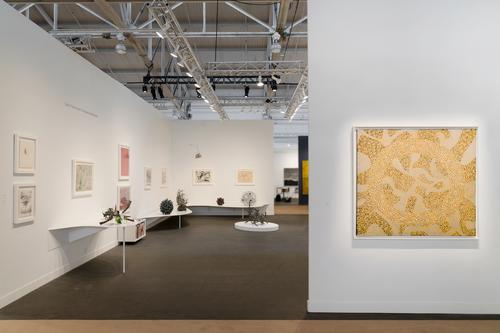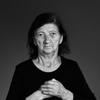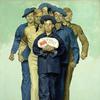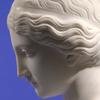
FOG Design+Art 2023, Booth 202
https://www.michaelrosenfeldart.com/exhibitions/fog-designandart-2023-booth-202
Following the success of our inaugural presentation at FOG Design+Art last year, Michael Rosenfeld Gallery is pleased to return to San Francisco with Claire Falkenstein & Postwar Abstraction, a celebration of American artists working in abstraction in the middle decades of the 20th century centered on the career of Claire Falkenstein (1908–1997). Dating from 1951–1974, Falkenstein’s works are contextualized by a rich selection of works on paper from the same period by Lee Bontecou, Elaine de Kooning, Jay DeFeo, Beauford Delaney, Michael Goldberg, Hans Hofmann, Lee Krasner, Alfred Leslie, Norman Lewis, Conrad Marca-Relli, Alfonso Ossorio, Jackson Pollock, Alma Thomas, and Mark Tobey.
A pioneering modernist known for her radical material experimentation, Claire Falkenstein is remembered for her prolific oeuvre that comprises sculptures in ceramic, wood, glass, and a variety of metals, as well as a strong body of paintings, works on paper, and prints. Falkenstein’s art was inspired by her diverse interests, which included theoretical physics, mathematics, and the natural world, often embodying a key concept that undergirds much of her work, namely the tangible relationship between stasis and movement, or, “structure and flow,” as she phrased it. Claire Falkenstein & Postwar Abstraction includes sixteen standout Falkenstein sculptures from each major series of her career, as well as nine works on paper and two canvases from her Moving Point series. Comprising layered, dynamic fields of rhythmic marks that coalesce into a larger form, Falkenstein’s Moving Point works generate the impression of swarming action. Continuums and aggregate structures are prevailing concepts in Falkenstein’s works—both two- and three-dimensional—as is a reliance on improvisation during the compositional process; the resulting works impart a feeling of organic, open-ended growth and proliferation, allowing a host of interpretations related to collective movement, from the trajectory of sub-atomic particles to the swell of waves in the sea.
A stunning highlight of the exhibition is a monumental sculpture dating to 1957, Time is Concrete No. 1, which represents one of the earliest examples of Falkenstein’s signature melding of metal and glass. A culmination of Falkenstein’s artistic development in Paris, this landmark sculpture exemplifies Falkenstein’s unique formal language, which often blends her calligraphic and architectonic impulses, coalescing into a form that transcends category. Material experimentation was a constant source of inspiration for Falkenstein, and her investigations into the possibilities of glass as a sculptural material in the mid-1950s resulted in perhaps her most famous series of sculptures, the Fusion works. After encountering Murano glass during a trip to Venice, Falkenstein began testing various ways to incorporate the material into her metal sculptures. She soon determined a way to securely bond the two materials in her kiln, allowing the glass to melt in unpredictable ways over the metal armatures of her sculptures. The Fusion works thus exemplify a number of dichotomies: design and accident, hard and fluid, dark and light, durable and delicate.
Claire Falkenstein & Postwar Abstraction also includes an important early example of Falkenstein’s experiments with suspended sculpture, Architecture Organique (1951). This work is one of the first examples of the artist’s welded metal sculptures designed to be hung from the ceiling, where it becomes a spectacle of shifting line and shadow as it interacts with the light and air currents in the space in which it is installed. Two years after completing Architecture Organique, Falkenstein initiated a body of sculptures she referred to as the Sun series; featuring an intricate web of enclosed metal lattices that the artist described as “linear drawings in space,” the Sun sculptures are intended to evoke the impression of a continuously expanding and contracting celestial body. Suspended from the ceiling or displayed on a floor, these works reflect Falkenstein’s preoccupation with “opening up mass and making space visible,” an aim expressed in her sculptures’ unique capacity to move through, interlace with, or define space—rather than taking up a solid volume as in traditional sculpture in the round.
A selection of midcentury abstract works on paper by Falkenstein’s peers is also on view in Booth 202, providing a clear sense of the milieu in which she developed her practice. Works by artists from both coasts as well as a fellow expatriate working in Paris—Beauford Delaney—both resonate and converse with the sculpture on view. Boldly hued, gestural works by Delaney, Elaine de Kooning, Michael Goldberg, Lee Krasner, Alfonso Ossorio, and Alma Thomas will be complemented by expressively textured, neutrally toned collages by Alfred Leslie and Conrad Marca-Relli. An emphasis on line defines the lyrical compositions of Norman Lewis, Jackson Pollock, and Hans Hofmann, while the intimately scaled works of Jay DeFeo and Lee Bontecou respectively transform an everyday object into a dynamic abstraction and describe a biomorphic realm of cosmic proportions. Finally, a potent group of white writing paintings on paper by an artist Falkenstein greatly admired, Mark Tobey, demonstrate the formal and structural affinities between the two artists’ approach to composition. As a whole, the installation will contextualize Falkenstein’s contributions to the canon of 20th-century abstraction among a survey of exemplary works by major midcentury American abstractionists.
Though she spent a formative decade in Europe soaking up the independent spirit of Paris’ international avant-garde, Falkenstein’s relationship to California was as longstanding as it was reciprocal. After a childhood in rural Oregon, Falkenstein first established herself as an artist in northern California in the 1930s and 1940s; she studied art at UC Berkeley, opened her first solo exhibition at San Francisco’s East-West Gallery in 1930 and studied under Alexander Archipenko and László Moholy-Nagy at Mills College in Oakland. In the 1940s she began teaching at the California School of Fine Arts (now the San Francisco Art Institute), and by the end of the decade, she had been awarded multiple solo exhibitions at the San Francisco Museum of Modern Art, the Crocker Art Museum, the de Young Museum and the Santa Barbara Museum of Art. Falkenstein moved to Paris in 1950, quickly falling in with fellow expatriate artists aligned with the influential French critic Michel Tapié. Her career continued to blossom during her time in Europe, and the vibrant cultural environment combined with her material success allowed her to develop several different series simultaneously. She settled permanently in Venice, California, in 1963, where she continued to expand her oeuvre over the next thirty years. Falkenstein exhibited regularly until her death in 1997 and completed numerous private and public commissions across California until the late 1980s, when her declining physical health forced her to stop working on large-scale sculptures.
Michael Rosenfeld Gallery began exhibiting the work of Claire Falkenstein in the late 1990s. Since then, her work has consistently been a vital component of the gallery’s program, and in 2014, Michael Rosenfeld Gallery became the exclusive representative of The Falkenstein Foundation. In 2016 the gallery mounted Claire Falkenstein: A Selection of Works from 1955–1975 in conjunction with the artist’s career retrospective at the Pasadena Art Museum of California Art, Beyond Sculpture. Two years later, Michael Rosenfeld Gallery opened Claire Falkenstein: Matter in Motion to critical acclaim and published a beautifully designed catalogue featuring a tribute to Falkenstein by sculptor Lynda Benglis and the complete transcript of the artist’s final interview conducted by critic Paul J. Karlstrom.
- Contact:
- Nicole Martin
- nm@michaelrosenfeld.com
- 212 247 0082
















